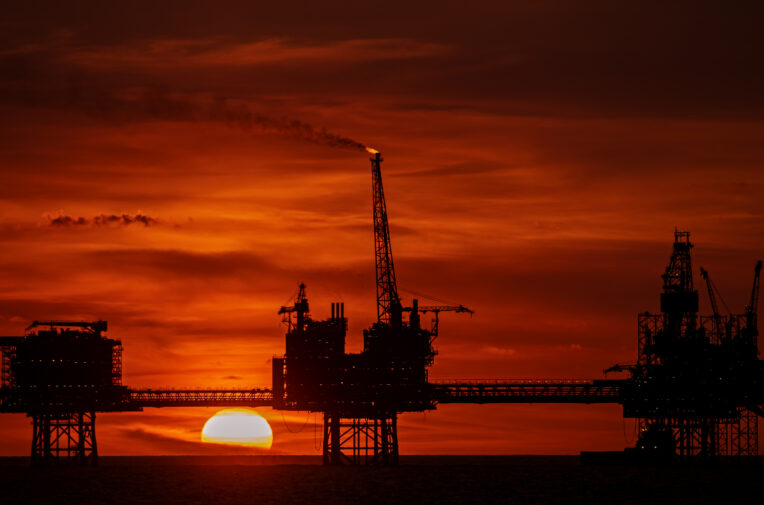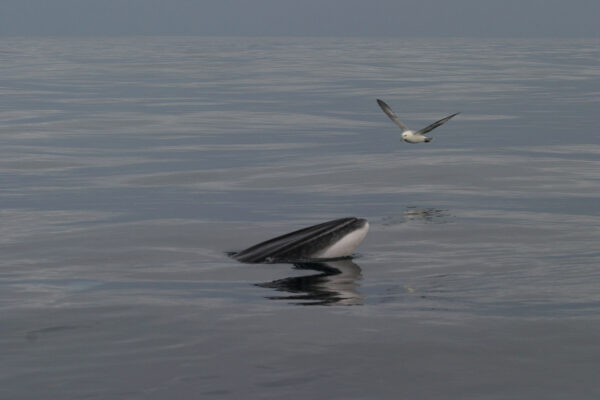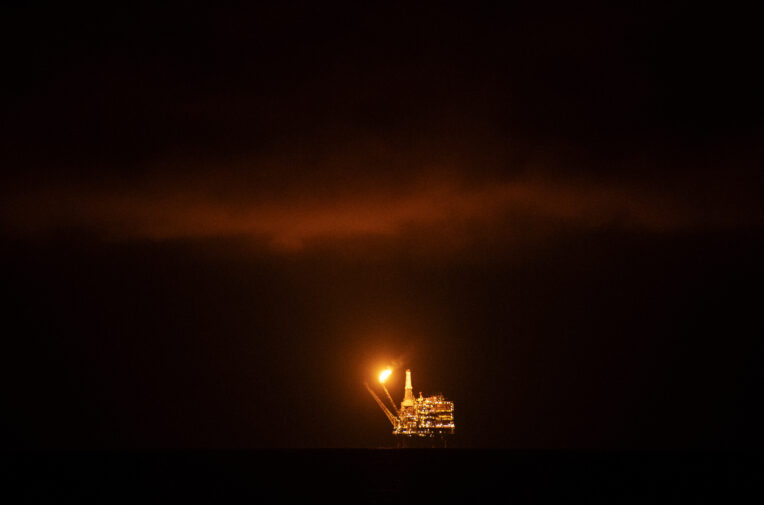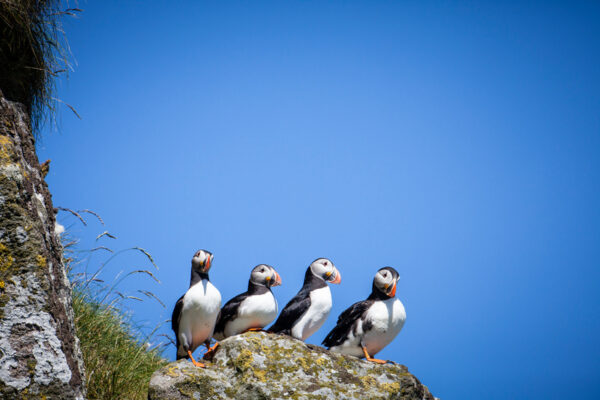
A gas platform in the North Sea. The UK announced new oil and gas licences, some of which are in marine protected areas. Photo by Marten van Dijl via Greenpeace
More than a quarter of newly approved oil and gas blocks fall in marine protected areas
New UK offshore licences for the multinational oil giants Shell and Eni are among those sitting within sensitive conservation sites
More than a quarter of newly approved oil and gas blocks fall in marine protected areas
New UK offshore licences for the multinational oil giants Shell and Eni are among those sitting within sensitive conservation sites
A gas platform in the North Sea. The UK announced new oil and gas licences, some of which are in marine protected areas. Photo by Marten van Dijl via Greenpeace
More than a quarter of the offshore oil and gas sites licensed by the UK government last month sit within marine protected areas (MPAs) prized for their rare habitats and species, an Unearthed analysis has revealed.
Granting new oil and gas licences in our marine protected areas makes a mockery of our climate pledges
– Hugo Tagholm, director of Oceana UK
At the end of last month, the North Sea Transition Authority (NSTA), a regulatory body responsible for overseeing oil and gas operations in the UK, awarded companies licences to develop or explore for oil and gas resources in 64 offshore sites, known as ‘blocks’, in UK waters.
An Unearthed analysis has found that 17 of these blocks (27%) sit wholly or partly within an MPA.
The new licences were hailed as “common sense” by the government, which later unveiled plans to bring in mandatory annual licensing rounds, as part of prime minister Rishi Sunak’s promise to ‘max out’ North Sea oil and gas reserves.
But ocean conservation groups warned that new oil and gas activity in protected conservation areas had the potential to cause “devastation” to “wildlife and habitats that are vital to ocean health.”

“Granting new oil and gas licences in our marine protected areas makes a mockery of our climate pledges, decimates our already suffering ocean life and threatens coastal communities,” Hugo Tagholm, director of Oceana UK, told Unearthed.
Tagholm said that drilling the seabed destroys vital habitats like cold-water corals and deep-sea sponge communities, and that in addition to the risk of catastrophic large-scale oil spills, “smaller, routine spillages from these developments can, and do, pollute the UK’s seas on a daily basis.” A September 2023 Unearthed investigation found that more than half of the oil accidentally spilled by UK offshore oil and gas operations in the past decade ended up in MPAs.
Even before drilling starts oil and gas operations can damage sea life in MPAs, Tagholm added.
“In the exploration phase, seismic airgun surveys – which are used almost exclusively in offshore oil and gas exploration – emit an ear-splitting noise that is 100,000 times more intense than a jet engine. These blasts deafen animals that rely on echolocation like dolphins, and can cause feeding disruption and even death among a range of ocean life.”
Caroline Lucas, Green Party MP said, “this government trampling all over these protection zones with reckless oil and gas drilling won’t cut people’s energy bills or provide greater energy security – but it will line the pockets of mega-wealthy fossil fuel giants, and do tangible damage to our critical marine life.”

While an exploration licence doesn’t always lead to a production field, the NSTA says that the new licences were “prioritised because they have the potential to go into production more quickly than others.”
About half of the 27 licences will start development in known reserves, while the others will begin exploration.
A spokesperson for the Department for Energy Security and Net Zero said the UK had a “comprehensive legal framework of stringent environmental protection measures for all offshore oil and gas activities”.
He added: “Prior to any licenses being awarded, OPRED [the Offshore Petroleum Regulator for Environment and Decommissioning] carries out a screening exercise to determine whether any activity is likely to have a significant effect on a relevant site.”
A NSTA spokesperson said: “Vulnerable and protected habitats and species are considered throughout the licensing and permitting process and licences are only awarded when the NSTA has received permission from OPRED that their environmental assessment requirements are met.”
The NSTA has emphasised that, even after a licence is granted, the licensee will still need to get further consents from the authority before they can conduct seismic surveys, drill exploration wells or progress towards full production.
More than half of the blocks awarded last month (11 out of 17) that sit within or overlap MPAs went to the oil giant Shell UK. A further three went to a subsidiary of the Italian oil company Eni, and three to Athena Exploration.
Shell declined to comment for this story.
A spokesperson for Eni told Unearthed that while the company’s licence area “partially overlaps” with a marine conservation zone, “no activity of any kind has ever been foreseen in the area that falls within the marine protected area”.
Entire ecosystems will be negatively impacted by destructive oil and gas exploration
– Anna Moscrop, policy manager at Whale and Dolphin Conservation
The MPA most-affected by the new tranche of licences is the the North-east Faroe-Shetland channel, which is believed to be a migration route for marine mammals, including fin whales and sperm whales. In total 11 of the blocks approved sit wholly or partly within this conservation area, including eight of the Shell blocks.
“MPAs are key habitats that support the UK’s rich marine life, including whales and dolphins, and entire ecosystems will be negatively impacted by destructive oil and gas exploration,” said Anna Moscrop, policy manager at Whale and Dolphin Conservation.
She told Unearthed that the Faroe-Shetland channel is “one of the largest designated nature conservation MPAs.”
“It is a vital corridor for migrating whales moving between high latitude feeding grounds and breeding areas to the south, and for deep diving species such as sperm and beaked whales which feed in deep waters,” she added. “Fragile and vulnerable deep sea sponges and cold water corals are also found here.”
Earlier this year, the government announced plans to issue hundreds of new licences for North Sea oil and gas. The licences awarded last months are just the first batch of blocks to be approved in the current licensing round. The NSTA says that more blocks will be offered in this round, subject to additional environmental checks.
The new blocks were granted a month after the approval of the controversial Rosebank project, the UK’s largest untapped oil field off the coast of Scotland, which according to Equinor’s environmental statement will involve building a new pipeline that cuts through the Faroe-Shetland Sponge Belt MPA.

Last month’s licence awards also included one block that sits wholly within the Faroe-Shetland Sponge Belt. The site is home to rare giant deep-sea sponges that, due to their appearance, are also known as “cheese bottoms.” The sponges often provide shelter for fish species, and their populations are only found in UK waters.
Other MPAs affected by last month’s tranche of licences included the East Gannet and Montrose Fields and the Fulmar marine conservation zone.
Protected areas like the East Gannet and Montrose Fields safeguard species such as the ocean quahog, one of the longest living creatures on Earth, and offer vital food sources for fish.
According to an Oceana report published earlier this year, 40% of all the new licences for oil and gas drilling in the North Sea that could be approved in the current round are within marine protected areas.
According to the Joint Nature Conservation Committee (JNCC), the public body responsible for nature conservation in the UK’s offshore marine environment, the protected features of each of these MPAs are “considered to be sensitive to pressures associated with…‘licensable activities.’”
However, the JNCC also notes that activities like oil and gas exploration within these MPAs follow regulations outlined in The Marine & Coastal Access Act. Under these rules, JNCC advises the regulator on developments that could significantly impact the MPA’s protected features and hinder conservation goals.
“It is increasingly clear that effective protection mechanisms are not in place to ensure that designated marine protected areas and protected species are safe from harm and damage around the UK,” said Moscrop.
Unearthed used shapefiles provided by the North Sea Transition Authority, outlining the new blocks and mapped them against them onto a map of Marine Protected Areas from the Joint Nature Conservation Committee (JNCC) using QGIS.
There are several types of MPAs in the UK. Our analysis included all offshore MPAs:
- Special Areas of Conservation (SACs)
- Special Protection Areas (SPAs)
- Marine Conservation Zones (MCZs) in England, Wales, and Northern Ireland
- Nature Conservation Marine Protected Areas in Scotland (NCMPAs)
- Highly Protected Marine Areas (HPMAs)
We then used NSTA’s ‘Table of potential awards by administrators’ document, which outlines all 32 licences (27 new and 5 existing), their owners and block IDs to cross reference the locations of each block in QGIS with the locations of MPAs.
The UK government granted a total of 58 offshore blocks on October 30, resulting in 27 new licences. Additionally, six blocks were merged into five existing licences.

